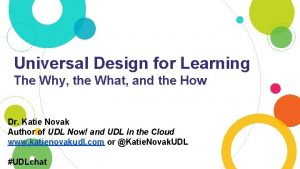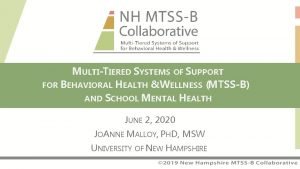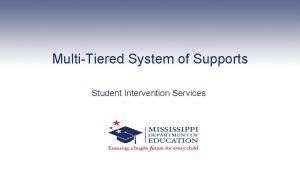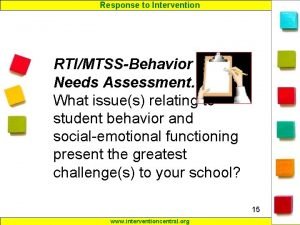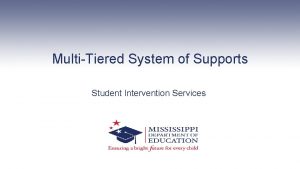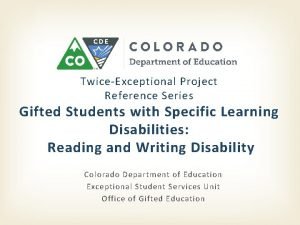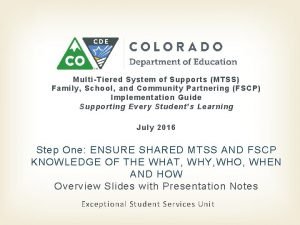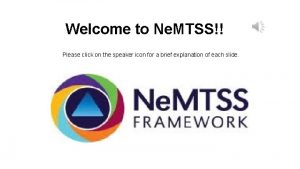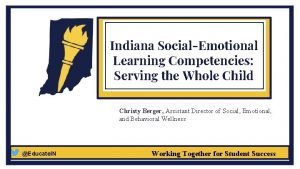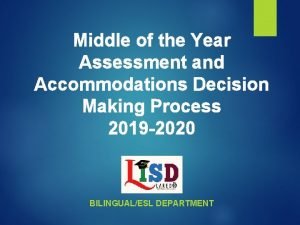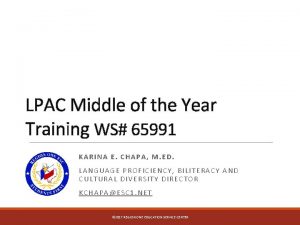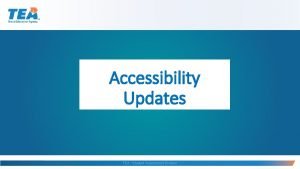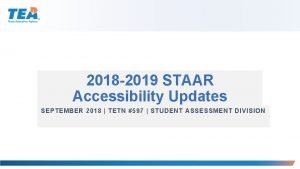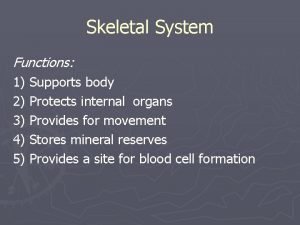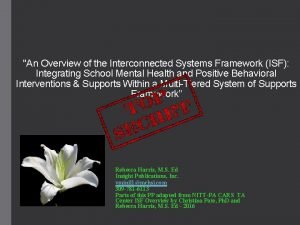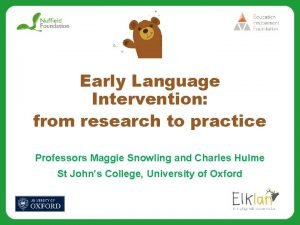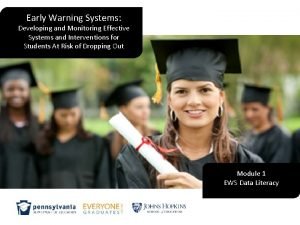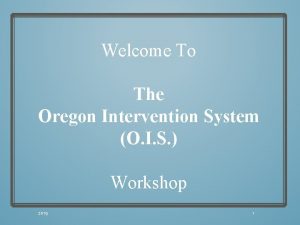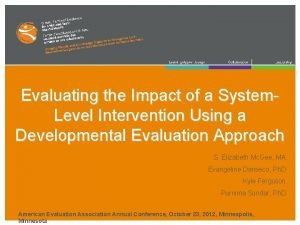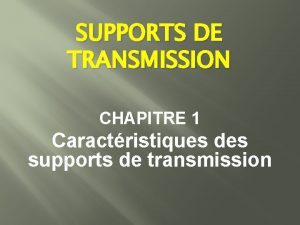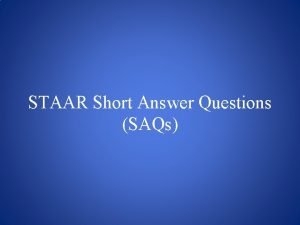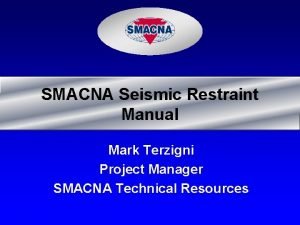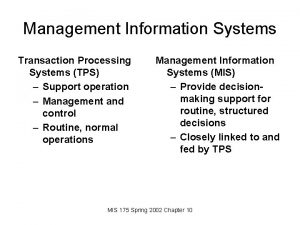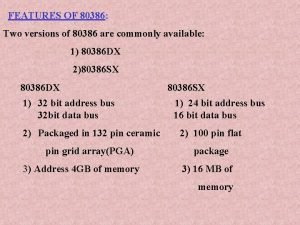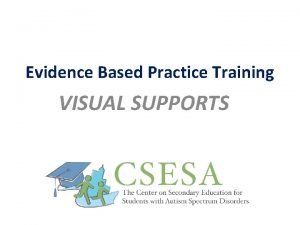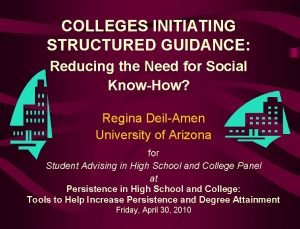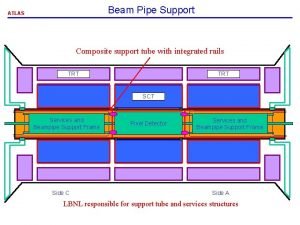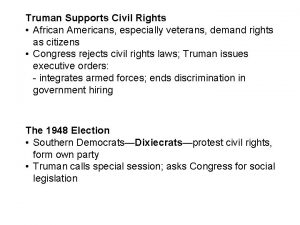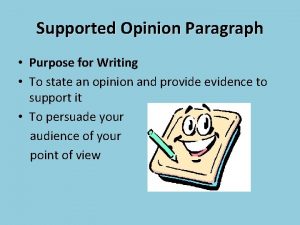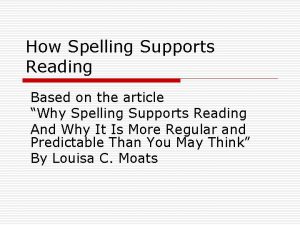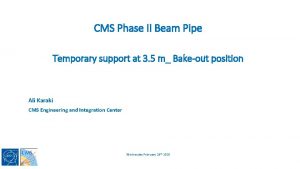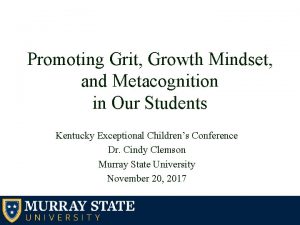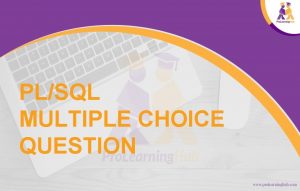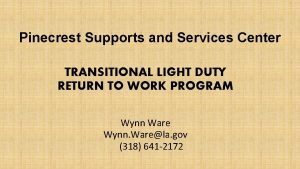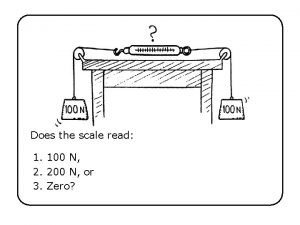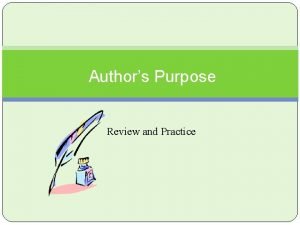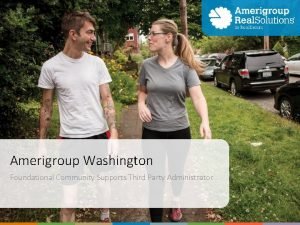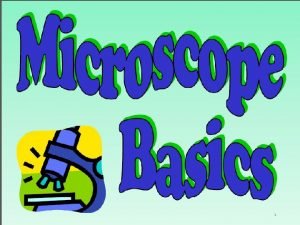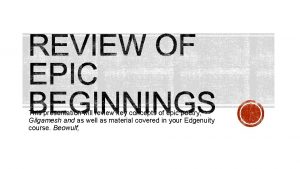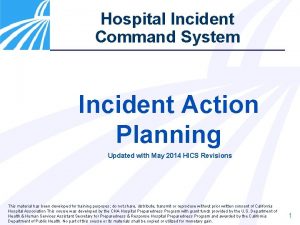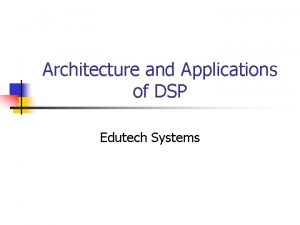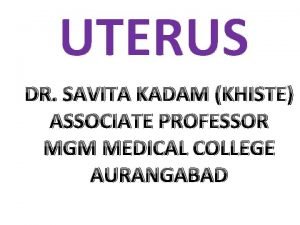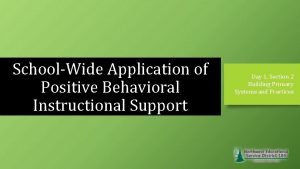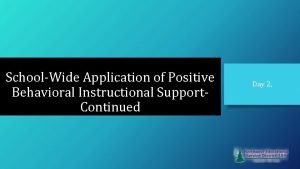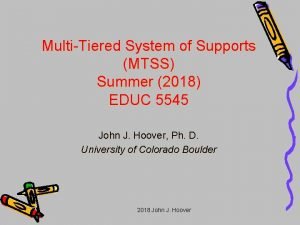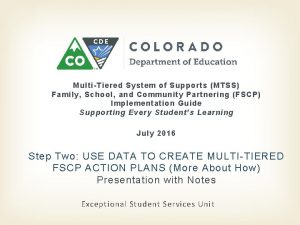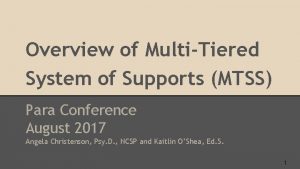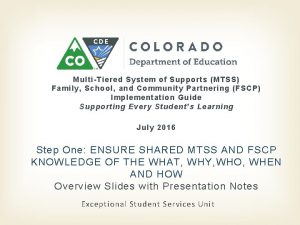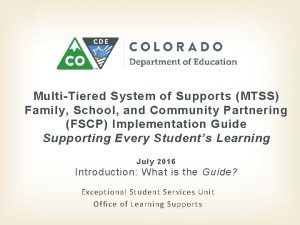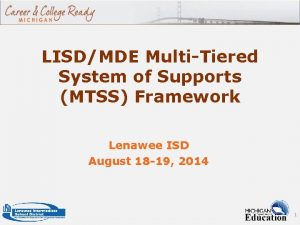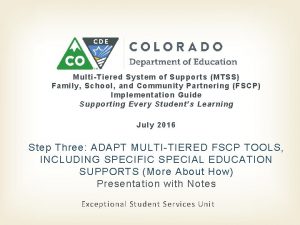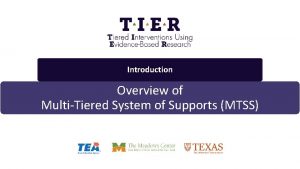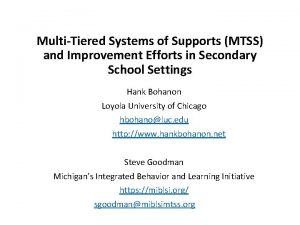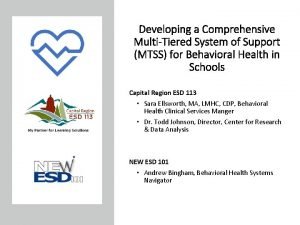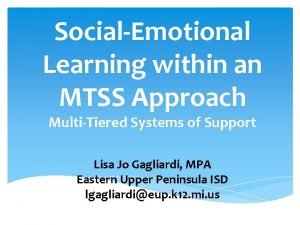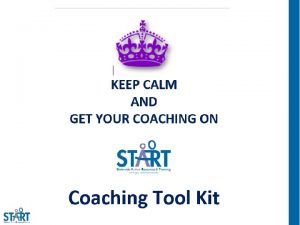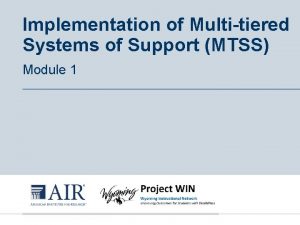LANGUAGE INTERVENTION IN MULTITIERED SYSTEM OF SUPPORTS MTSS




























































- Slides: 60

LANGUAGE INTERVENTION IN MULTI-TIERED SYSTEM OF SUPPORTS (MTSS) 2 nd Annual MO-CASE Collaborative Conference Presentation March 2, 2018

OVERVIEW • This panel of speech-language pathologists will provide an overview of how language interventions can be utilized within a Multi-Tiered System of Supports (MTSS) as an effective approach to improve educational outcomes for students. The panel will discuss collaboration of resources and strategies, opportunities for intervention and suggestions for collection of progress monitoring data.

LEARNING OBJECTIVES • Participants will gain an understanding of how language interventions fit into multi-tiered systems of support. • Participants will be able to describe a variety of approaches to provide support to students in the area of language strategies, interventions and data collection.

DISCLOSURES Presenter Financial Non-Financial Elizabeth ”Beth” Mc. Kerlie, M. S. , CCC-SLP Employed as Speech/Language & Related Services Coordinator, North Kansas City School District -Member and President – Missouri Speech-Language. Hearing Association -State Education Advocacy Leader (SEAL) ASHA/MSHA -Member of American Speech. Language-Hearing Association Patricia “Pat” Jones, M. S. , CCCSLP Employed as Speech-Language Pathologist, Liberty Public Schools -Member and Vice President for School Services Missouri Speech-Language-Hearing Association -Member of American Speech. Language-Hearing Association

DISCLOSURES CONTINUED Presenter Financial Non-financial Dawn Callahan Dennis, Ed. D Employed as Process CCC-SLP Consultant and Speech. Language Department Chair of the Saint Joseph School District -Member of American Speech-Language-Hearing Association Elizabeth “Beth” Daire, M. S. , CCC-SLP -Member of American Speech-Language Hearing Association Employed as Speech. Language Pathologist, Raymore-Peculiar R-II School District -Member of Missouri Speech-Language-Hearing Association -Member of Missouri Speech- Language-Hearing Association

LANGUAGE – THE FOUNDATION/BASIS behavior academics LANGUAGE

IDEA DEFINITION OF SPEECHLANGUAGE SERVICES • Speech-language pathology services include: • Identification of children with speech or language impairments • Diagnosis and appraisal of specific speech or language impairments • Referral for medical or other professional attention necessary for the habilitation of speech or language impairments • iv. Provision of speech and language services for the habilitation or prevention of communicative impairments • v. Counseling and guidance of parents, children, and teachers regarding speech and language impairments • CFR 300. 34(c)(15)

SPEECH LANGUAGE SERVICE IN THE SCHOOLS TRADITIONAL APPROACH CURRENT APPROACH l. Work with students with identified disability only l. In addition to students with disabilities, provide early intervention/prevention for all students in general education l. Specific students, specific, discrete skills l. All students, functional skills, curriculum/academics l. Isolated service delivery in speech room, long-term therapy l. Various service delivery methods including more collaboration or consultation, short-term/intensive therapy and/or cycles to maximize general education access l. Difficultly generalizing skills across environments l. Increased generalization of skills

ASHA ROLE/RESPONSIBILITIES OF SLP IN SCHOOLS • ASHA 2010 Critical Roles in Education Range of Roles and Responsibilities Collaboration Leadership Across all levels Range of disorders Prevention School-wide services Advocacy & communication Educational relevance Assessment intervention Unique contributions of Parent training SLP training Language/literacy focus Data collection and analysis students Cultural and linguistic diversity Partnerships – families, Professional universities development, lifelong learning, research Program design and compliance Supervision and mentorship

SKILLS NEED BY SLPS • ASHA’s Roles and Responsibilities • Strong collaboration skills • Ability to apply research to practice • Analytical skills • Subject area expertise • Strong teaching skills

WORKLOAD VS CASELOAD APPROACH • Workload accounts for the number of minutes serviced, severity of students (high intensity/self contained programs), intervention groups, travel and other duties as assigned including supervision, mentorships, leadership roles and building duties. • Caseload accounts for the number of students and type of programming serviced.

WORKLOAD VS. CASELOAD CONTINUED • Many school districts are utilizing a workload approach to increase their ability to serve students and hire high-quality speech-language pathologists • NKC Schools considers a workload approach in order to incorporate: number of students case managed; number of students related service; total minutes per IEPs; number of minutes per week serviced; total number of speech intervention students; participation on building based teams and responsibilities; travel • At the SJSD, when collecting SLP Caseload Data we include: number of students case managed; number of students related service; total service minutes (total minutes per IEPs); number of minutes per week serviced (scheduled minutes); total number speech intervention students.

WORKLOAD VS. CASELOAD CONTINUED • In Liberty Public Schools • LPS has implemented the Workload Model as an option for speech language services delivery. This model provides direct speech language services to some students for three consecutive weeks, and indirect services for one week. Prior to the beginning of school, each Speech. Language Pathologist will be provided with a schedule of which week are direct and indirect for the school year. • To accommodate the Workload Model, all speech/language minutes on IEP’s get calculated monthly. During the IEP meeting with parents, the Speech-Language Pathologist needs to explain the Workload Model and how it benefits the student.

WORKLOAD VS. CASELOAD CONTINUED • When determining staffing needs and assignments at Ray-Pec, the following is considered: total number of IEP students case managed, total number of IEP students seen through related services, total number of IEP service minutes provided, total number of intervention students seen and minutes provided, along with other additional responsibilities (SLP-A Superivision, CFY-Supervision, etc. )

DYNAMIC SERVICE DELIVERY • Service Delivery should be dynamic • Frequency (number and type) • Number of direct sessions – change to direction and consultation/collaboration over time • Duration (length) • 30 minutes to start - Reduce to 15 when skills increase • Location (where) • Classroom - Therapy room • Other school environments

EVERY STUDENT SUCCEEDS ACT (ESSA) • President Obama signed the Every Student Succeeds Act (ESSA) into law on December 10, 2015. • ESSA includes provisions that will help to ensure success for students and schools • Advances equity by upholding critical protections for America's disadvantaged and high-need students. • Requires—for the first time—that all students in America be taught to high academic standards that will prepare them to succeed in college and careers. • Ensures that vital information is provided to educators, families, students, and communities through annual statewide assessments that measure students' progress toward those high standards.

EVERY STUDENT SUCCEEDS ACT (ESSA) CONTINUED • Helps to support and grow local innovations—including evidence-based and place-based interventions developed by local leaders and educators— consistent with our Investing in Innovation and Promise Neighborhoods • Sustains and expands this administration's historic investments in increasing access to high-quality preschool. • Maintains an expectation that there will be accountability and action to effect positive change in our lowest-performing schools, where groups of students are not making progress, and where graduation rates are low over extended periods of time. • Clarification on relaxation of funding for SLPs – use SLPs in interventions • Specialized Instructional Support Personnel (SISPs) are to be involved in the literacy development of students (paves the way for MTSS)

EVERY STUDENT SUCCEEDS ACT (ESSA) CONTINUED • Specific relation to speech-language pathology • Helps clarification on relaxation of funding for SLPs – use SLPs in intervention • Specialized Instructional Support Personnel (SISPs) are to be involved in the literacy development of students (paves the way for MTSS)

MULTI-TIERED SYSTEM OF SUPPORT (MTSS) • A Multi-Tiered System of Support(s) is. . . • a whole-school, data-driven, prevention-based framework for improving learning outcomes for every student • through a layered continuum of • evidence-based practices and system of supports

ROLE OF SLP IN MTSS/RTI • Participate in teams • Support district wide initiatives • Participate in design of MTSS framework which includes a focus on language and literacy and SLP involvement • Development of in-service material, training, etc. • Development of communication with parents, students, teachers • Roles can change as students move through supports

SLP ACTIVITIES IN RTI Tier 1 Tier 2 Tier 3 MTSS/RTI team member Skill-specific interventions More frequent, more intensive intervention Observations of students Small groups of same skills Even smaller group Screenings Programmed approach Individualized interventions Consultation with teachers, parents 2 -4 times a week Intensive support 4 -5 times week Co-teaching language and literacy lessons Collaboration with teacher (checklists, observations, etc) Consideration of possible referral for evaluation

PROGRESS MONITORING • Limited commercially available • Progress- monitoring tool development: • Identify progress-monitoring procedures that facilitate data-driven decisions • Graph student progress – easy way to analyze and share student progress information • Aimline/goal line, etc.

DATA COLLECTION – MTSS/RTI • MTSS • Whole school • Benchmark data • PBIS • RTI • Individual student • Intervention – progress monitoring data

DATA BASED DECISION MAKING • Graphing data for decision making purposes • Aimline/goal line: - criterion to reach the target skill • Trendline: graph of student progress toward competency of the skill • Consider fidelity of implementation of intervention • Outcomes • • Continue intervention as is Increase intensity, change intervention Go back to tier 1 Consider referral

LANGUAGE AS BASIS FOR ACADEMICS & BEHAVIOR • Adequate language skills provide a solid foundation for literacy and academic work • Language occurs throughout a student’s school day • Early intervention is a basic premise of an RTI model; prevention is a key role and responsibility for SLP • Language skills provide the roots or the foundation for academics (learning, literacy, decoding, comprehension, etc. ) • Vocabulary knowledge and reading comprehension are interdependent • Listening and speaking vocabulary is important to reading and writing vocabulary development • Oral language skills linked directly to written language skills

USE A LANGUAGE LENS TO LITERACY • Does the student have the underlying language skills to learn the curriculum? • Language skills provide the roots or the foundation for academics (learning, literacy) – • good reading skills = decoding + comprehension • Both decoding and comprehension depend on strong language skills

The Effects of Weaknesses in Oral Language on Reading Growth (Hirsch, 1996) 16 High Oral Language in Kindergarten 15 14 5. 2 years difference Reading Age Level 13 12 11 Low Oral Language in Kindergarten 10 9 8 7 6 5 5 6 7 8 9 10 11 12 13 Chronological Age 14 15 16

SCARBOROUGH, 2001

COMPONENTS OF LANGUAGE • Morphology • Syntax • Semantics • Pragmatics • PHONOLOGY

PRACTICAL APPLICATION TIPS • Integrate SLP into school teams to the extent possible • Start small • Think in terms of prevention services first • SLP Schedule/Workload – where to fit in? • Use intervention data to augment evaluation data

NORTH KANSAS CITY SCHOOL DISTRICT • SLP is a member of the school’s problem solving team and participates to the fullest extent possible based upon workload - focus early intervention • One of the earliest districts using RTI for eligibility for learning disabilities • In 2005 adopted procedures for RTI for speech/voice/fluency - Speech Improvement Program which includes parent permission form • In 2009 -2010 adopted procedures to utilize an RTI approach for language and other communication concerns (still honoring discrepancy eligibility criteria) • Through the district’s RTI framework, all K students and students in other grade levels receiving academic/behavioral interventions within an RTI framework, are screened for hearing, speech and language

NORTH KANSAS CITY SCHOOL DISTRICT CONTINUED • Based upon comparison of district benchmark data (Aimsweb, PBIS, etc. ) and S/L screening info, SLP helps devise speech or language interventions • Focusing on language interventions: • screenings completed in a somewhat “universal” manner – same forms/procedures are utilized and interpretations made similarly between SLPs across district (through professional development/training) • NKC intervention toolkit – a resource for SLPs for most common language intervention needs • Tier 1 – general classroom strategies for speech and language • Tier 2 – common language interventions based upon discrete language skills

NORTH KANSAS CITY SCHOOLS CONTINUED • NKC Language Toolkit • Discrete language skills - i. e. , vocabulary – antonyms, categories, similarities/differences; syntax – verb tense; morphology – pronouns, verb tense; metacognitive language skills such as sequencing, predicting, etc. • interventions have ”direct instruction” type directions for activities so any trained person can deliver the intervention and several people can implement the same intervention systematically with fidelity • A directions sheet, materials, and data sheet is provided to the implementer of the intervention • Data collected is analyzed by the SLP for progress monitoring purposes

NORTH KANSAS CITY SCHOOLS CONTINUED • Decisions made as a problem solving team to make a change in the intervention, increase complexity or intensity, etc • Becomes easy to see what is a delayed skill vs. what is a potential impairment in language • Those who respond – most likely referral and services will not be needed and student is observed to exhibit skill deficits/delays • Those who don’t respond likely need referral • Important implications for referral and current eligibility criteria • Do not delay suspected disability • Continue interventions in evaluation phase and include in report

NORTH KANSAS CITY SCHOOLS CONTINUED • Future directions • Monitor impacts on workloads • Continue collaborative work at the MTSS level – whole school/child • Work within a framework for providing oral language opportunities for children through SLP involvement • Participate on building-based school teams • Provide professional development opportunities at the building level • Work on clear understandings of “screening” and “consultation” • Skills developmentally appropriate • Interventions recommended

LIBERTY PUBLIC SCHOOLS • SLP is member of the school’s teacher assistant team and participates in weekly meetings. • SLP provides recommendations for interventions in the classroom. • The SLP may be instrumental in identifying those students in the general educational classroom who are at risk due to difficulties with phonemic awareness, comprehension, and other spoken and written language skills that affect academic success. • The SLP can help teams understand the link between spoken and written language, demonstrate how language weaknesses affect literacy.

LIBERTY PUBLIC SCHOOLS CONTINUED

LIBERTY PUBLIC SCHOOLS CONTINUED • SLP can assist the classroom teacher in the following ways: • Collaborate with teachers to review achievement tests, curriculum-based assessments, and other data to determine if the student’s problems may be related to communication skills. • Analyze communication expectations within the classroom. Understanding classroom expectations can help teams in selecting individual adaptions, such as modifying pace, content, or length of instruction. • Provide suggestions for enhancing the physical learning environment with language and literacy-rich materials and experiences. • Model communication-facilitating strategies in the classroom. • Assist in identifying research-based interventions for the classroom. • Suggest classroom accommodations.

LIBERTY PUBLIC SCHOOLS CONTINUED • Assist in creating data collection systems for progress monitoring. • Assist teachers in breaking down tasks into smaller parts. • Train classroom assistants to support communication in the classroom. • Help families understand the connection between language and literacy and ways they can support oral language and literacy in the home.

LIBERTY CONTINUED • Examples of interventions • Zones of Regulation • Whole Body Listening • Visual Schedules

LIBERTY CONTINUED • In 2008 LPS adopted procedures for RTI for speech, voice and fluency. • Responses to Intervention Speech Services (Rt. I) are appropriate for: • Sound error(s) • Fluency difficulties • Voice differences (ENT consult or medical referral necessary) • Rt. I speech services can be provided by the SLP. After a student received a speech screening, and the SLP determined the student has non-developmental sound error(s) (Using the MO Sound System Disorder Normative Data Chart), fluency difficulties, and/or voice differences. The SLP can recommend the student receive Rt. I Speech Services. • Request for Parent Permission to Provide Rt. I Speech Services Form needs to be completed by the SLP, sent home, and signed by the parent/guardian PRIOR to the provision of Rt. I Speech Services for that student.

ST. JOSEPH SCHOOL DISTRICT • 2009 -2010: • The SJSD adopted the idea of speech interventions through the Rt. I process. • This process has evolved over the years to a district-wide systematic procedure to completing speech interventions. • This had minimal success. • SLPs had a hard time letting go of the IEP process. • Lack of emphasis on educational impact.

ST. JOSEPH SCHOOL DISTRICT CONTINUED • As of 2016: • This includes a referral form, parent consent letter, an adopted screening procedure, report template format and parent consent letter to receive interventions. • It was at this time we saw an increase of the Rt. I intervention process for speecharticulation. • Emphasis on Education Impact. • The use of interventions for language was also added. • The SJSD adopted the use of the CELF-5 screener as a district-wide screening measure. • A flow chart was created to help teams with decision making. • SLP Department compiled classroom strategies for all aspects of language: syntax, semantic, morphology, and pragmatics. • Recommendation to improve our speech and language referral forms when disability is suspected from staff.

ST. JOSEPH SCHOOL DISTRICT CONTINUED • 2017 -18: • The SJSD adopted the MTSS model district-wide. • On-line resources available for academics and behaviors. • SLP provides language strategies. • Continued need to educate and collaborate with General Education Staff regarding components of language, characteristics of language disability and means to support within the classroom. • Improved/revised referral forms continues to be on the “to do” list.

RAYMORE-PECULIAR SCHOOL DISTRICT • In 2008 -2009 adopted procedures for RTI for speech/voice/fluency, Speech Interventions. • In 2010 -2011 adopted procedures to utilize an RTI approach for language and other communication concerns (still honoring discrepancy eligibility criteria). • Speech/language Interventions are provided by the building SLP collaborates/consults with classroom teacher regarding necessary classroom supports/strategies.

RAYMORE-PECULIAR SCHOOL DISTRICT CONTINUED • Referrals for language screenings are processed through the building SAT (Student Assistance Team). • SLPs serve in a consultative manner on this team. • Current language screener is CELF-5 Screening Test. Pass/Fail considered along with functional language use, observations made by classroom teacher, interventionist, and SLP. May also use a district developed checklist or the ORS (Observational Rating Scale) from CELF-5.

RAYMORE PECULIAR SCHOOL DISTRICT CONTINUED • Procedure • Language concern is identified by school staff member (classroom teacher, interventionist, etc). • Student concerns are brought before the building SAT (Student Assistance Team). • Parents are notified about the concern by the person who noted the concern. • Permission to screen form is sent home. • Screening is completed and results are shared with SAT. Recommendations are made regarding need for language interventions and specific targets.

RAYMORE PECULIAR SCHOOL DISTRICT CONTINUED • Procedure Continued… • Screening results and intervention plan (if developed) are shared with parents. • Students are typically seen twice weekly for 20 minute sessions, but student needs are considered individually. • Progress on targets is reported to parents quarterly. • Student progress is tracked and reported to building SAT team. • Lack of adequate or expected progress on targets warrant special education referral.

RAYMORE PECULIAR SCHOOL DISTRICT CONTINUED • Future Directions: • Monitoring impact on SLP caseload. • Look to further develop tier 2 model of interventions. • Greater SLP involvement on school teams. • Continued professional development opportunities.

PRACTICAL APPLICATION • Integrate SLP into school teams to the extent possible • Start small • Think in terms of prevention services first • SLP Schedule/Workload – where to fit in? • Use intervention data to augment evaluation data

KEYS FOR SUCCESS • General education staff needs to be trained on characteristics of students showing language weakness • Training all staff to understand Speech vs. Language • Data collection for referrals should be specific – data based decisions • Make strategies easily accessible (available on district web site) • Include SLP on support teams and SLPs embrace role

PROPOSED ELIGIBILITY CRITERIA • The proposed changes to the speech/language eligibility criterion all consider the provision for interventions prior to suspecting a disability The language impairment adversely affects the child’s educational performance as documented by lack of response to evidence based interventions designed to support progress in the general education curriculum.

PROPOSED ELIGIBILITY CRITERIA • Intent is to ensure RTI, MTSS type general education interventions have been implemented before consideration for IDEA eligibility. Apply to all SL eligibility criteria. • Can be curricular interventions (e. g. reading) and/or speech-language specific interventions. Can be implemented by any appropriate provider, teacher, para, SLP-A, SLP, etc.

MSHA HANDBOOK FOR SCHOOL BASED SLPS • MSHA is creating a handbook/guidelines document for school-based SLPs • The purpose is to give some best practice guidance to encourage consistency in the state • Guidance includes: • Sample checklists • Sample general education observation forms • Sample progress monitoring tools

A FINAL WORD • Language is the developmental foundation for educational and academic success. • Language should be an integral part of MTSS/RTI. • Give language equal consideration to academics and behavior.

LANGUAGE – THE 3 RD PILLAR academics language Language behavior

QUESTIONS

CONTACT INFO Presenter District Phone/email Beth Mc. Kerlie North Kansas City School District (816) 321 -4565 Beth. mckerlie@nkcschools. org Pat Jones Liberty Public Schools (816) 736 -5440 pat. jones@lps 53. org Dawn Dennis St. Joseph School District 816 -671 -4000 dawn. dennis@sjsd. k 12. mo. us Beth Daire Raymore-Peculiar R-II School (816) 892 -1964 District elizabeth. daire@raypec. org

REFERENCES • American Speech-Language-Hearing Association. (2010). Roles and responsibilities of speech- language pathologists in schools [Professional Issues Statement]. Available from www. asha. org/policy • Colorado Department of Education (2016) Mutli-Tiered System of Supports: http: //www. cde. state. co/us/MTSS • Ehren, B. (2007, September 25). Responsiveness to Intervention: An Opportunity to Reinvent Speech-Language Services in Schools. The ASHA Leader, • Ehren, B. , Montgomery, J. , Rudebusch, J. , & Whitmire, K. (2006). Responsiveness to intervention: New roles for speech-language pathologists. Available from http: //www. asha. org/SLP/schools/prof-consult/New. Roles. SLP/ • Flynn, P. (2010, August 31). New Service Delivery Models: Connecting SLPs with Teachers and Curriculum. The ASHA Leader. • Gillam, S. , Gillam, S. Making Evidence-Based Decisions About Child Language Intervention in Schools. Lang Speech Hear Serv Sch, Oct 2006; 37: 304 - 315. • Hirsch (1996) The Effects of Weaknesses in Oral Language on Reading Comprehension Growth cited in Torgesen, J. (2004). Current issues in assessment and intervention for younger and older students. Paper presented at the NASP workshop. • Justice, L. Evidence-Based Practice, Response to Intervention, and the Prevention of Reading Difficulties. Language Speech and Hearing Services in the Schools, Oct 2006, 284 -297.

REFERENCES CONTINUED • www. mo-edu-sail. org • Montgomery, Judy & Barbara Moore-Brown, Response to Intervention: An Alternative to Special Education. ASHA, 2006. • Power-de-Fur, L. (2011) Special Education Eligibility: When Is a Speech-Language Impairment Also a Disability? , The ASHA Leader, Vol. 16, 12 -15. • • Rudebusch, J. (2007). Guide to RTI. Austin, TX: Pro-Ed. Rudebusch, J. (2008). The source for RTI. Austin, TX: Pro-Ed. Roth, Froma P. et al. , RTI in Action: Oral Language Activities for K-2 Classrooms. ASHA, 2010. Scarborough, H. 2001. Connecting early language and literacy to later reading (dis)abilities: Evidence, theory, and practice. Pp. 97 -110 in S. B. Neuman & D. K. Dickinson (Eds. ) Handbook of Early Literacy. NY: Guilford Press. • Sexton, S. , & Seth, L. (2009). 5 -minute therapy: An alternative service delivery model for speech sound disorders. Available from http: //www. 5 minutekids. com/Research. Article. pdf • Speedy Speech. www. speedyspeechtherapy. com • https: //www. ed. gov/essa? src=ft
 Mtss and udl
Mtss and udl Christy berger
Christy berger Mtss-b
Mtss-b Mde mtss documentation packet
Mde mtss documentation packet Mtss needs assessment
Mtss needs assessment Mtss documentation packet
Mtss documentation packet Benefits of mtss
Benefits of mtss Mtss
Mtss Mtss nebraska
Mtss nebraska Trazabilidad mtss
Trazabilidad mtss Mtss infographic
Mtss infographic Idoe mtss
Idoe mtss Ricas grade 3-8 math
Ricas grade 3-8 math What are content and language supports
What are content and language supports Tea content and language supports
Tea content and language supports What are content and language supports
What are content and language supports Which system supports the body
Which system supports the body Pros and cons of pbis
Pros and cons of pbis Neli listening rules
Neli listening rules Early warning intervention and monitoring system
Early warning intervention and monitoring system Oregon intervention system
Oregon intervention system System-level intervention
System-level intervention Supports intensity scale rating key
Supports intensity scale rating key Support de transmission cable coaxial
Support de transmission cable coaxial Staar short answer response
Staar short answer response Snmp ports
Snmp ports Seismic restraint manual
Seismic restraint manual Transaction processing system characteristics
Transaction processing system characteristics Descriptor table in 80386
Descriptor table in 80386 Visual supports evidence-based practice
Visual supports evidence-based practice Structured guidance and supports
Structured guidance and supports Helius composite support
Helius composite support Truman supports civil rights
Truman supports civil rights How to write an opinion paragraph
How to write an opinion paragraph Title 22 rcfe prohibited conditions
Title 22 rcfe prohibited conditions Historical background of period of activism
Historical background of period of activism How spelling supports reading
How spelling supports reading The pipe assembly supports the vertical loads shown
The pipe assembly supports the vertical loads shown 26108-17 raceways and fittings
26108-17 raceways and fittings Preext
Preext What is adm in accenture
What is adm in accenture Where were the renaissance
Where were the renaissance Body tube microscope
Body tube microscope Metacognition and growth mindset supports grit
Metacognition and growth mindset supports grit What is the result of the following 'vik' null 'ram'
What is the result of the following 'vik' null 'ram' Pinecrest supports and services center
Pinecrest supports and services center She holds the book stationary against the wall
She holds the book stationary against the wall The author wrote this passage to
The author wrote this passage to Fcs amerigroup
Fcs amerigroup Monocular microscope parts and functions
Monocular microscope parts and functions Christianity vs paganism chart
Christianity vs paganism chart Supports the incident action planning process
Supports the incident action planning process Optical fiber waveguides
Optical fiber waveguides Dsp computational building blocks
Dsp computational building blocks Lig pubocervical
Lig pubocervical Supports the body
Supports the body An aluminum shaft with a constant diameter of 50mm
An aluminum shaft with a constant diameter of 50mm Positive behavioral interventions and supports
Positive behavioral interventions and supports Positive behavioral interventions and supports
Positive behavioral interventions and supports Anther clipart
Anther clipart School leaver employment support 1
School leaver employment support 1
